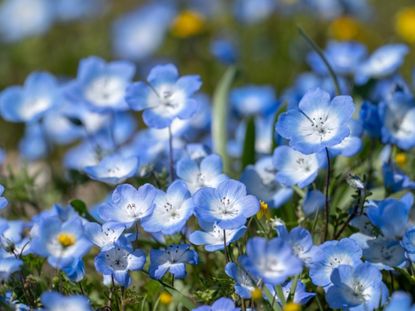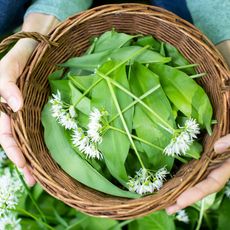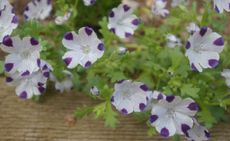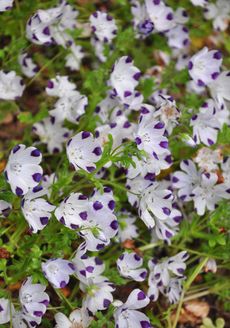Baby Blue Eyes Plant - Growing And Caring For Baby Blue Eyes


Baby blue eyes plant is native to part of California, particularly the Baja area, but it is a successful annual in many other parts of the United States. Learn how to grow baby blue eyes for a spectacular display of soft blue or white flowers that attract important garden pollinators. Butterflies, bees, and other helpful insects use the nectar as food. Growing baby blue eyes ensures these important insects stay in your yard to help pollinate other flowers and vegetables.
Baby Blue Eyes Plant
Baby blue eyes (Nemophila menziesii) is a low spreading, shrub-like plant that has succulent stems and flowers with six curved blue petals. Baby blue eyes may get 6 to 12 inches (15-31 cm.) high and over a foot (31 cm.) wide. The blue flowers have a romantic, soft hue that shows well with other pastel flowers as part of a native wildflower garden. You can expect baby blue eyes flowers in late winter where temperatures are moderate and the plant blooms until late spring to early summer. The baby blue eyes flower is an excellent plant to use in rockeries, containers, and massed as border plants in annual gardens. They create one of the first displays of annual color after the snow and ice have melted. Baby blue eyes plants are native wildflowers in California and arid zones. They are an important part of the coastal prairie and easy to grow and care for as a garden plant.
How to Grow Baby Blue Eyes
The baby blue eyes flower is easy to start from seed. Choose a site with full sun to partial shade and one that provides some shelter from drying winds. The plant does well in sandy, gritty soils and has some drought tolerance. In fact, light sandy soil makes the best seed bed for the baby blue eyes flower, as it drains well. Wait until soils warm to nearly 60 degrees F. (16 C.) before sowing the tiny seeds. Sow seeds just under a fine layer of soil about 1/16 inch (2 mm.) thick. Baby blue eyes flower will germinate in seven to ten days where there is cool weather and short days. Keep the seed bed lightly moist until germination. Baby blue eyes plant seeds readily but does not transplant well. Fortunately, the plant is easy to sow and takes off quickly.
Caring for Baby Blue Eyes
Since baby blue eyes is a low growing plant with a succulent stem and leaves, caring for baby blue eyes requires little maintenance. It has moderate drought tolerance but will die back when confronted with severe dry conditions. The plant does not need fertilizer when planted in areas with organically rich soil. Pinch the tips of the growth to force bushier plant formation. Once the plant has flowered and seed heads formed, cut them off and dry them in a paper bag. Shake the bag after a week and then pick out the larger pieces of chaff. Save the seeds until the following spring and re-sow for a new crop of this wonderful plant.
Gardening tips, videos, info and more delivered right to your inbox!
Sign up for the Gardening Know How newsletter today and receive a free download of our DIY eBook "Bring Your Garden Indoors: 13 DIY Projects For Fall And Winter".

Bonnie Grant is a professional landscaper with a Certification in Urban Gardening. She has been gardening and writing for 15 years. A former professional chef, she has a passion for edible landscaping.
-
 Elegant Exotics: 8 Beautiful Amaryllis Varieties That Will Brighten Any Holiday Display
Elegant Exotics: 8 Beautiful Amaryllis Varieties That Will Brighten Any Holiday DisplayWhether red, pink, white or variegated, the right amaryllis varieties can enhance any living space, especially during the holidays. We round up eight of the most exquisite
By Bonnie L. Grant
-
 Forage For Herbs: 7 Tasty And Safe Wild Herbs To Pick Close To Your Own Backyard
Forage For Herbs: 7 Tasty And Safe Wild Herbs To Pick Close To Your Own BackyardIn addition to growing your own herbal staples, did you know there are several wild options out there that are safe and tasty – and free? Try foraging these 7 wild herbs
By Amy Grant
-
 Growing Five Spot In Containers – Tips For Keeping Five Spot In A Pot
Growing Five Spot In Containers – Tips For Keeping Five Spot In A PotAlso called calico flower or baby blue eyes, growing five spot in a pot provides a beautiful backdrop for taller plants. Combine it with perennials, other annuals, or ornamental grasses and foliage plants. Learn more about container-grown five spot plants in this article.
By Bonnie L. Grant
-
 Five Spot Seed Propagation – Growing Baby Blue Eyes From Seeds
Five Spot Seed Propagation – Growing Baby Blue Eyes From SeedsFive spot annuals develop into low growing plants adorned with white flowers whose petal tips have been dipped in bright blue. They are propagated by seed and will self-sow at the end of the season. Find out when to plant five spot seeds and how to care for them here.
By Bonnie L. Grant